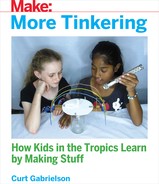Chapter 17
Plate Tectonics
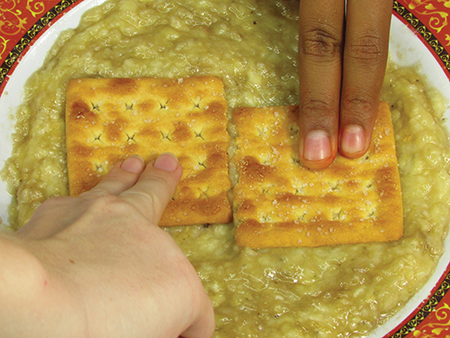
Fathom how the ground beneath us moves.
we named our kid after the tallest mountain in Timor: Ramelau. At 3,000 meters (10,000 feet), it’s 800 meters taller than Australia’s tallest mountain. The continent of Australia is enormous compared to the island of Timor—200 times the area—and has its own continental shelf under the sea. But still, Ramelau is not hard to understand if you believe in plate tectonics.
When I say “believe in,” I’m not being silly or religious. I’m saying when scientists look at data that have been collected over decades of research, they can decide that one theory is more effective than the others at explaining the situation and thus probably correct. They believe it. The beliefs held by scientists are based on the interpretation of data and always open to revision by new data or new interpretation. We try our best to avoid being skewed by emotion.
When I was young in the 1970s, my teachers didn’t teach me about plate tectonics. It was a brand-new idea and somewhat outrageous. After all, aren’t continents that emerge, float around, and sometimes sink beneath the ocean the stuff of science fiction? But it turns out that one of the issues that dogged the theory of evolution for so long was still dogging scientists in the mid-twentieth century: the gargantuan expanse of geologic history.
The earth is so old you can’t imagine it. Think you can? Forget it. You’ll be on the fortunate side of statistics if you live to be 100 years old. If you’re really fortunate, you heard stories from your 100-year-old great-grandma before she died, and before you die you’ll meet your great-granddaughter and repeat some of the stories your great-grandma told you. That’s seven generations, and it hardly ever happens. A personal, once-removed story spanning five generations is about all you can usually get—less than 200 years.1
But the earth is 4,600,000,000 years old—twenty million times longer than those stories extend! And shoot, archeology finds the oldest bones of proto-humans are only 2 million years old, which is still only 1/2000th of the history of the earth. Check out the earth’s history timeline later in this chapter.
The conclusion? We humans are super-newcomers to the planet, and as individuals we just don’t stick around long enough to see many rocks change. Some tectonic plates are moving at the rate of around a centimeter a year. So in 200 years, you’ve got about two meters of movement. I don’t care how meticulous Great-Grandma was in her records, you can’t expect to see this difference with normal observations. The geologists of old can be forgiven for thinking mountains and valleys and continents have always been there and will never move.
But move they do, relentlessly, unstoppably, and with dire consequences for the lands we call home. In these tinkering activities, you’ll use crackers and cookies as tectonic plates and watch them move. What you’re seeing happen in your little models here takes hundreds of millions of years to happen on the surface of our planet.
Gather stuff and tools
- Plates, 2
- Water
- Bananas
- Fork
- Table knife
- Crackers (Stiff ones work better, stiffer than saltines, stiffer than graham crackers, though those kinds will also work.)
- Powdered sugar and/or sprinkles
Tinker
That looks like a fairly happy little set of tinkering supplies, eh? And it’s true: if you’re careful and keep everything clean, you can eat the results of this first tinkering session!
First we’ll set up the asthenosphere, the upper plastic-like part of the mantle. This will be represented by smooshed-up bananas in your plate. You don’t need a deep layer of banana mush to make the asthenosphere—maybe one or two normal bananas2—but be sure it’s smooshed up well with the fork.

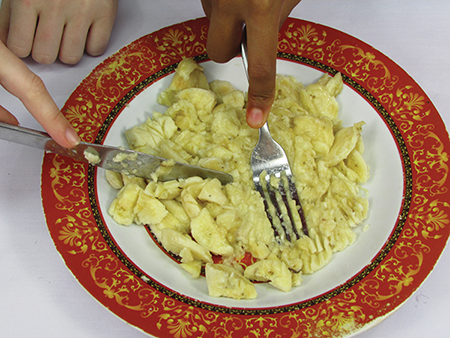
The square crackers will represent tectonic plates that float atop the asthenosphere. We’ll investigate the three different types of interaction between plates:
- Convergent (pushing together)
- Divergent (pulling apart)
- Transverse (moving lateral to one another)
First the transverse: get two crackers and chisel shallow teeth into one side of each. The teeth should more or less fit into each other, though it’s not important that they fit tightly tooth to tooth.

Before you drop them onto the banana asthenosphere, try the setup on the tabletop; put them together tightly and then push both together and laterally—that is, one forward and one backward.

They should not move yet—just put on pressure in these two directions. Now chuck them into the plate and set it up again on top of the mush.
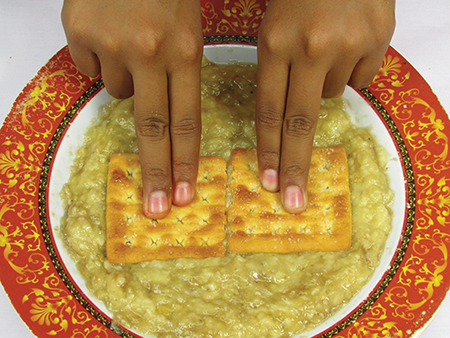
Begin putting force on them like you just practiced, pushing them together as well as one forward and one backward. This time, continue pushing harder and harder until they suddenly move.
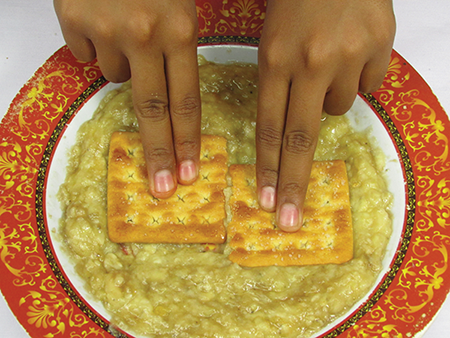
That was an earthquake, by the way, and a decent model of a transverse tectonic plate motion. Try it a few more times while you’ve got it set up.
The next one is divergent plate motion. This is the easy one. Put two crackers in, press them down a bit, and pull them apart.
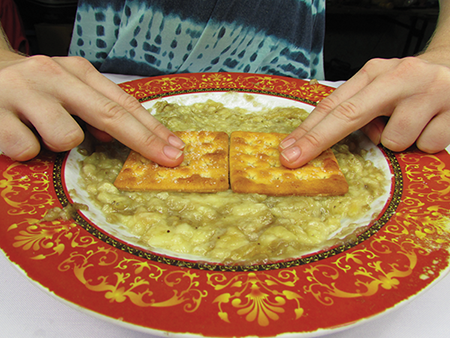

Notice the mid-oceanic ridge that forms from the banana mush rising between the two crackers. More on that in a bit.
Finally, the convergent model. We’ll do two versions. The first involves softening one of the crackers. Put some water in a plate and lay a cracker so that maybe one-third of it is in the water.

How long you leave it will depend on the kind of cracker. The ones shown here (Square Puff Indonesian-made, a staple of our snack diet here) are quite resilient, and we leave them for almost a minute. Graham crackers will sog up in a few seconds.
When you have a somewhat soggy edge to your cracker, put it on the top of the banana mush and put another hard one next to it.

Now steadily press them toward each other and watch what happens.
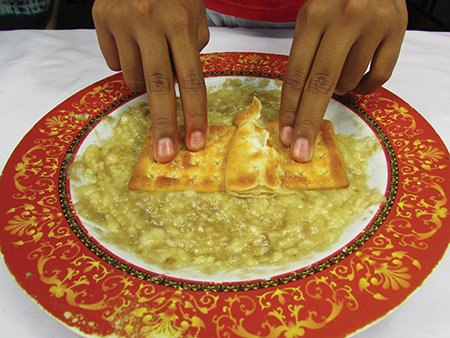

You can see that on ours the soggy part crumpled up on top of the hard one; a mountain was raised.
We can model another way mountains are raised when plates converge. Here we’ll use our sprinkles and/or powdered sugar. So lay two new hard crackers (no sogging necessary) on top of the banana asthenosphere and spread a generous layer of sugar or sprinkles on top of both of them.
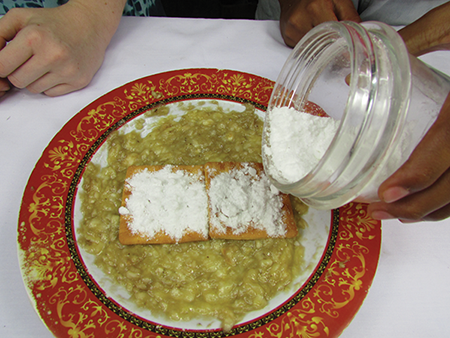
Now help one of the crackers go down below the other. This motion is called “subduction.”
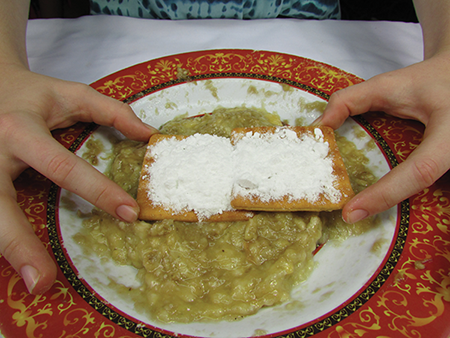
When one is clearly going under the other, gently and steadily push them toward one another and witness again accelerated geologic history in your plate.
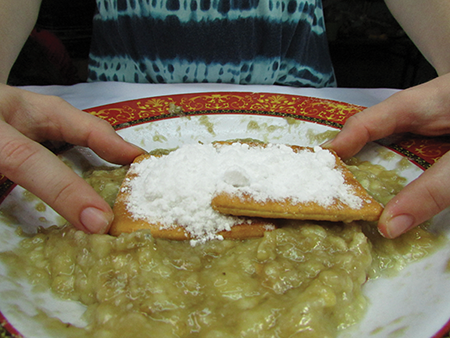
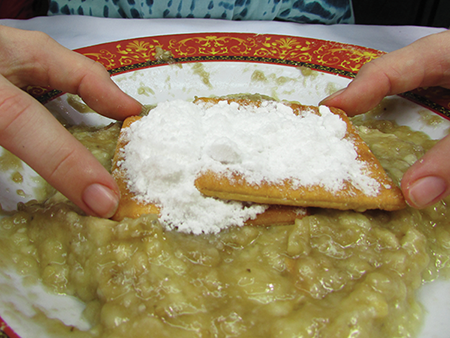
Did you get a magnificent little sugar mountain, like we did?
What’s Going On?
Here is a diagram of the earth’s tectonics plates. The key thing to notice is the borders between them, where the situations you just modeled take place.

CREDIT: United States Geological Survey
Let’s start with the transverse situation. In my adopted home of California, the San Andreas Fault runs the length of this state. The plate to the west of it is slowly scraping to the north, and the plate to the east is slowly scraping to the south. In 1989 a massive earthquake called the Loma Prieta struck just before game 3 of the World Series and was broadcast live to the world. This serious plate movement ruined a large swath of the greater San Francisco area, as well as my future home of Watsonville.
The Pinnacles is part of an extinct volcano made into a national monument (and great rock climbing spot). Most of the remains of this volcano are not far from Watsonville, but part of it is 195 miles away to the south! That massive old volcano erupted 23 million years ago right on the San Andreas Fault line, and the plates kept on moving, carrying one half south and one half north. Amazing.
Divergent plate boundaries are found in the middle of the Atlantic Ocean among other places; many maps show this. The rocks found at these boundaries are straight from the asthenosphere, and the age of the rocks increases with the distance from the center of the plate boundary. This is evidence that the plates are moving apart and that new rock is formed when the hot ooze from the asthenosphere comes up in the resulting space, just like your smooshed-up banana did.
Converging plates often create mountains. In reality, there is no exact parallel between hard and soggy crackers. Plates are made of all different sorts of rocks, and whether one goes up over or down under depends on a bunch of different factors. We softened one cracker just to show more or less what happens when one bunches up in a converging situation.
To tell you the truth, a geologist friend of mine said the crackers in this model are not quite accurate, because real plates are flexible and bendable. She was talking about rocks like granite, basalt, and so forth—not exactly what I would usually describe as bendable. But when you look around Timor, you realize it’s true; rocks bend all the time at great pressure and temperature, and this results in folds, buckles, uplifts, and tilts, and when they break, it turns into a fault. So the soggy cracker is actually quite an accurate representation.
Mount Ramelau, and the entire island of Timor-Leste, is in the other category of converging plates, the powdered sugar and sprinkles one. Timor Island is sitting on the far northern edge of the Indo-Australian plate, and this plate is being subducted—that is, shoved underneath the Eurasian plate. Logically speaking, you’d expect the land here to be going down and the land on the Eurasian plate to be rising and forming mountains as it goes up over us. But when you look at the rocks in Timor, you find a bunch of rubble: mostly bent, smashed, fragmented metamorphic and sedimentary rocks. This is the kind of stuff that’s being scraped off the Indo-Australian plate and resulting in the mountains of Timor.

Due to this rubble piling up, Ramelau increases in height around 10 cm each year, along with the whole island. That’s why folks here are not going to be affected much by the sea rising due to global warming; they’re rising even faster!
The highest mountain in the world is Everest, and it just happens to also be on the border of the Indo-Australian plate and the Eurasian plate. The same motion is happening there, with the Indo-Australian Plate pushing north and the Eurasian plate pushing south, and that similar situation has resulted in the rapid (you know, several tens of millions of years) uplift of the Himalayan mountains. Pretty fabulous, eh?
So that’s the basics of the motion of the tectonic plates. But there are no enormous fingers reaching down to push the real ones around, like you did in your model. Where does the force come from then? Tinker a bit more and the answer will emerge.
Gather more stuff
- Wok or big frying pan
- Water, 0.5 liters (two cups)
- Flour, ¼ cup
- Fork
- Rectangular sandwich cookies
- Stove
Tinker
Pour the water into the wok and stir in the flour. This is like making gravy, if you’ve ever done that, but with no grease.
Heat it on medium and observe what happens. That’s the asthenosphere you’re gazing at. Let it get nice and hot, maybe even boil a bit, until it turns a bit viscous—that is, sticky.
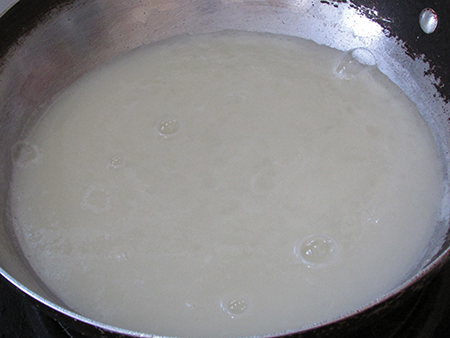
Can you see the little convection currents rising and swirling? That’s what happens in the asthenosphere.
Now let’s cover it with the lithosphere—the sandwich cookies. Turn the stove off for a moment. Lay the cookies on the surface of the gravy, wall to wall, right up next each other. Break some apart along diagonals to fill the open spaces around the edge. Leave some of them two layers, but take most of them apart to make one-layer pieces. The two-layer pieces will represent places where the lithosphere is thicker, like continents and mountain ranges. The one-layer pieces will represent thin plates and specifically oceanic plates. After you split one, if one side still has the disgusting sweet filling stuck to it, place it with that facing up. That stuff can represent the oceans.

Now turn the stove back on low and feast your eyes.

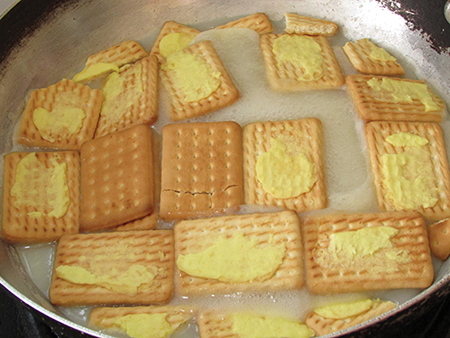
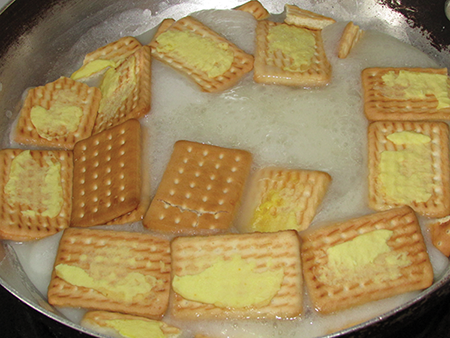
Everything is happening all at once here; you should be able to see examples of all three types of interaction among the tectonic plates in your gravy:
- Diverging zones, where the ooze is rising to create little mountain ridges between the edges of the plates, maybe in the midst of a frosting ocean
- Converging zones, where two plates are smashing into each other and one or both are tilting up, or one is sliding under the other
- Transverse zones, where two plates are scraping laterally to each other
It’s a veritable mini-tectonic-plate-a-rama in a wok, all powered by the convection and bubbling of the gravy asthenosphere.
What’s Going On?
The underlying (ha!) question has been answered: the force for moving the tectonic plates around comes from convection and circulation of the asthenosphere. This circulation was visible in the asthenosphere of your wok. The tectonic plate cookies were floating arbitrarily around on top of the churning asthenospheric gravy. That’s just what the real ones do, with the following differences:
- They move slowly, remember? Centimeters per year.
- They are enormous; the Pacific plate is around 20 percent of the whole earth’s surface.
- They are much denser and are formed of rocks instead of cookie material.
- For the most part, they’re not edible.
It’s important to see the position of the oceans. All this talk about floating may have you thinking that there is water underneath rocks. In reality, the world’s oceans are all sitting atop oceanic crust, which is in turn floating on the semi-liquid asthenosphere—your gravy in the model. That’s three distinct layers at the oceans: asthenosphere, lithosphere, ocean water.
Now, your wok model actually had boiling going on, with bubbles coming up. This is not exactly like the asthenosphere, in which the magma is not boiling per se, but actually the role of water at great depths—and that means great pressures and great temperatures—is one of the fundamental factors in rock formation and volcanic activity. So your little wok model is not so far off.
One thing that often happens in the wok model that is not so realistic is that cookie plates pile up and spread far apart, leaving a bubbling area of gravy asthenosphere with no cookie lithosphere above it. As I mentioned earlier, when plates diverge the liquid material from below flows up to fill the space. But it cools pretty much immediately and forms new rock. It doesn’t stay molten and bubbly very long. In fact, it’s important to note that the lithosphere is composed of a lot of the same stuff as the asthenosphere, the two mixing and blending back and forth as rock materials melt at lower, hotter levels and solidify at higher, cooler levels.
As I write this, the Kilauea volcano in Hawaii is spewing forth lava, reminding us that there is hot liquid down there—and also that we should give thanks for a hard, cool surface up here to live on.
